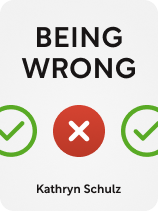

This article is an excerpt from the Shortform book guide to "Being Wrong" by Kathryn Schulz. Shortform has the world's best summaries and analyses of books you should be reading.
Like this article? Sign up for a free trial here.
What does it feel like to be wrong? How do our brains process the realization that we’ve made a mistake?
In her book Being Wrong, Kathryn Schulz explores the complex emotions and cognitive processes associated with error. She delves into the concept of “error blindness” and examines our reactions to discovering we’re wrong.
Keep reading to uncover fascinating insights into what it feels like to be wrong and how it impacts our daily lives.
What It Feels Like to Be Wrong
It’s easier to consider the pros and cons of being wrong on an intellectual level than it is to truly experience being wrong. This is because of what’s known as “error blindness”—our inability to see our own mistakes in the moment. How we react to discovering we’re wrong depends on how much our thinking has to change and whether that change will be pleasant or unpleasant.
So, what does it feel like to be wrong? There are two distinct reactions you can have to finding out that you’re wrong about something. The first is revulsion—immediately after making a mistake, such as calling a friend by someone else’s name, you might say, “I feel sick,” “I want to throw up,” or even “shoot me now,” all of which are expressions of pain and the desire to end it quickly. But Schulz says this isn’t our only mode of feeling. In addition to the pain of certain types of error, we also feel elation at a happy surprise, such as when you run into a friend you hadn’t expected to see for a while. Both types of error, both pleasant and painful, define how we feel about being wrong, though we tend to feel the negative more often than the positive.
| The Right Words Shape Your Reactions Schulz uses people’s common word choices to reflect how making mistakes makes us feel, but the relationship between words and feelings goes both ways—the language we use can influence our feelings, rather than our feelings dictating how we speak. Research has shown that putting negative feelings into words lessens their impact by shifting where the brain processes emotion from the primitive amygdala to the more highly developed prefrontal cortex, where reason and language mitigate strong emotions. If this is the case, then admitting to error and describing how it feels can literally change which part of your brain you use to cope with the fallout of making mistakes. Just as giving voice to the pain of making mistakes helps to soothe it, so too can the use of language steer your brain toward seeing mistakes in a more positive light. In The Happiness Advantage, Shawn Achor argues that the deliberate use of positive language—such as keeping a gratitude journal and writing down positive experiences in your life—will retrain your brain to see positive outcomes rather than dwelling on disappointment. In regard to the experience of error Schulz describes, a practiced and deliberate positive outlook can turn viewing mistakes as “happy surprises” into a more common occurrence. |
However, Schulz points out that the feelings we associate with being wrong always occur after the fact. In the instant you call your friend the wrong name or make an erroneous statement, you don’t feel as if you’re wrong at all, because in your mind you’re not. Therefore, the real-time experience of being wrong is no different from the experience of being right. What’s more, even when you discover that you’re wrong, you do so by replacing the wrong belief with a corrected belief. In other words, you don’t change from being wrong to right, you change from feeling that you’re right in one way to feeling that you’re right in a different way. The pain of mistakes is the pain of having been wrong, not that of being wrong in the present.
(Shortform note: The fact that everyone always feels like they’re right is part of what makes resolving conflicts difficult. Since, as Schulz says, the pain of being wrong comes after the realization, then suggesting that either side in a dispute is wrong invites them to feel that pain, which, of course, they’ll resist. This is why the authors of Difficult Conversations insist that arguing about who’s right or wrong is a useless approach to resolving disputes. What they suggest instead is to try to understand why each party believes they’re right so that everyone involved can understand why their “rights” are in conflict with each other.)
Schulz suggests that people don’t change a belief until they have a new one to replace the old one. For instance, in a flash, you’ll change one belief—“I left my car keys on the table”—to a corrected belief—“I dropped my car keys in the laundry.” This makes the moment of transition so elusive that in most cases it can’t be pinned down. It either happens instantly, as in the example of your keys, or so gradually that you don’t notice the change, such as a shift in a political view that happens over several years. We rarely, if ever, get stuck in the transition because, as a rule, we don’t reconsider beliefs in isolation—we always need two or more to compare, which can sometimes make changing a belief take a while.
(Shortform note: The mental frameworks that support our beliefs can be even more complex than Schulz presents. Just as beliefs don’t exist in isolation, they’re also reinforced by habits and behaviors based on those beliefs. In A Mind for Numbers, Barbara Oakley argues that to change an ingrained habit, such as using caffeine to stay awake at work, you have to change your beliefs about that habit as well as believing that the change will do you good. In this case, you’d have to believe a good night’s sleep is more beneficial than caffeine with none of the side effects. Many experts on personal growth acknowledge that changes like this take time—the delicate balance of belief and behavior has to be reordered in a way that won’t collapse.)
The Anxiety of Doubt
How tightly we cling to any given belief falls somewhere on the spectrum between doubt and certainty. Schulz argues that certainty is the default position for more of our beliefs than we realize, and, while that’s necessary for us to get through the day, it carries inherent dangers that only the discomfort of doubt can assuage.
Doubt provokes anxiety, which is why we find certainty so appealing. Schulz writes that people who wear their doubt on their sleeve, such as undecided voters or religious agnostics, make others uncomfortable not because they’re undecided, but because they display an openness to their own potential for error that undermines the sense of certainty that everyone else relies on.

———End of Preview———
Like what you just read? Read the rest of the world's best book summary and analysis of Kathryn Schulz's "Being Wrong" at Shortform.
Here's what you'll find in our full Being Wrong summary:
- Why you shouldn’t try to completely avoid making mistakes
- The reasons why you get things wrong
- How to make mistakes without falling victim to shame and denial






